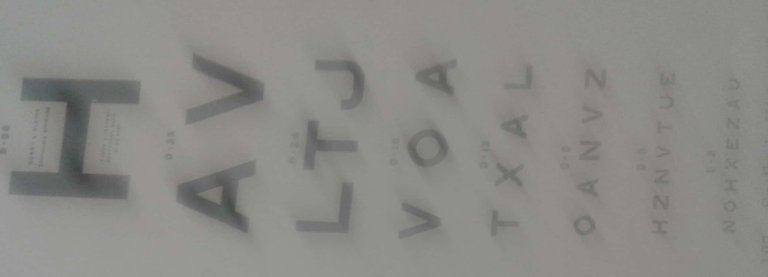
THEfunctional examination of the eye consists of testing the acuity of the forms of visual perception which have already been mentioned- the light sense, the colour sense, and the form sense. They are usually tested in the reverse order. Each eye must be tested separly throughout.
The Acuity of vision . The acuity of distant central vision is now almost invariably tested by means of senllen's Test Types . These are constructed upon the standard that the average minimum visual angle is 1 minute.
The types consist of a series of letters arranged in line each diminishing in size. The breadth of the line of which the letters are composed is such that the edges will subtend an angle of 1 minute at the nodal point of the eye at a particular distance. Each letter is of such a shape that it can be placed in a square the sides of which are five times the breadth of the constituent line. Hence the whole letter will subtend an angle of 5 minutes at the nodal point of the eye at the given distance.
To fulfil these conditions a letter used as a test a long distance from the eye must be larger and the constituent lines must be broader than in the case of a letter to be used nearer the eye. In snellen's types the largest letter will subtend 5 minutes at the nodal point if it is 60 metres from the eye. Those in the subsequent lies will subtend 5 minutes if they are 36,24,18,12,9 and 6 metres from the eye. Sometimes smaller letters corresponding to 5 and 4 metres are used. A person with average acuity of vision ought therefore to be able to read the top letter at 60 metres, the second line at 36, the third at 24, and so on.
For convenience the patient is kept at a fixed distance from the types. This distance should never be less than 5 and preferably 6 metres. At such a distance the divergence of the rays in the small bundle which enters the pupil is so slight that the rays can be considered parallel and accommodation is thus eliminated.
A normal patient 6 metres from the types ought to be able to read every letter from the top to the end of the 6 metre line; many people can read more in a good light . If the patient can only read the 18 metre line , his distant vision is obviously defective. The numerical convention which is used to record this is a fraction in which the numerator is the distance at which he is from the types,and the denominator is the distance at which a person with normal vision ought to be able to read the last line which he succeeds in reading .The patient under consideration will therefore have his distant vision recorded thus: V=6/18. The normal patient's vision will be V=6/6.

The amount of illumination on the test card has a considerable influence on normal visual acuity. It has been found that the acuity rises rapidly as the illumination is increased from zero up to 5-10 foot candles; and more slowly up to 1,000 or more ft. cs. The illumination of the test card should never be allowed to fall below 20 ft. cs. , and to allow for the deterioration of lamps with use it would be advantageous if a standard of 100 ft. cs. were used.
It the patient cannot read the largest letter he is told to walk slowly towards the types. at a certain ddistance he may be able to see the top letter. He should then be moved back a little, since he may not have understood exactly where to look. In this manner the farthest point at which he can distinguish the top letter is the farthest point at which he can distinguish the top letter is determined. If this is 3 metres, the vision is recorded thus V=3/60. If he is unable to see the top letter when close to it, he is asked to count the extended fingers of the surgeon's hand , held up at about 1 metre against a dark background; this is recorded thus-V=fingers at 1 metre. If he cannot count fingers the surgeon's hand is moved in front of the eye ; if he can distinguish the movements the vision is recorded as V=hand movements. If he is unable to see these he is taken into the dark room and a light is concentrated on his cye and he is asked to say when the light is on the eye and when it is off. If he succeeds in doing this , V=p.l (perception of light) and he may be able to give some indication of the direction from which the light is coming (projection of light, good or bad). If he fails to see the light the vision is recorded as V= no p.l.
The measurement gives the visual acuity of the eye unaided by lenses. It is necessary in all cases, however , to determine the function of the macula in the best optical conditions , and for this purpose the refraction of the eye, including the manifest hypermetropia must be determined , and the visual acuity taken again in the same way with the correcting glasses in place . If, for example, there are are two dioptres of hypermetropia, corrected visual acuity is then written : V=6/12+2D=6/6
Congratulations @rojia3254! You received a personal award!
You can view your badges on your Steem Board and compare to others on the Steem Ranking
Vote for @Steemitboard as a witness to get one more award and increased upvotes!